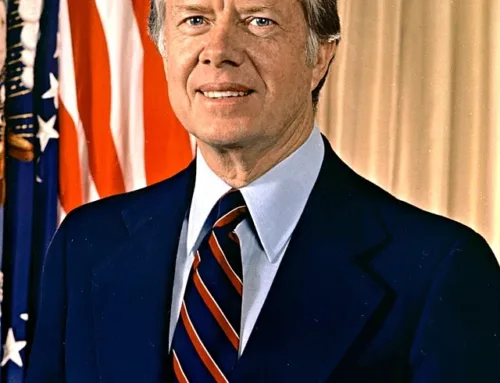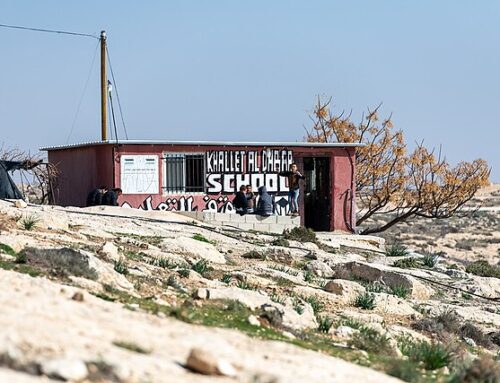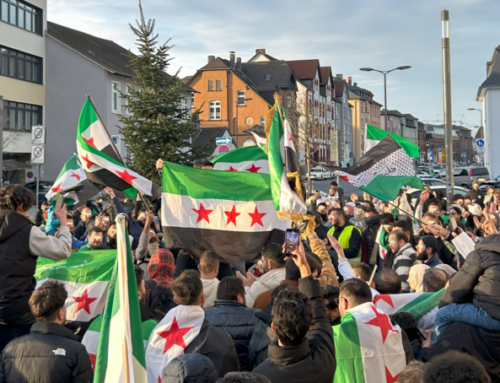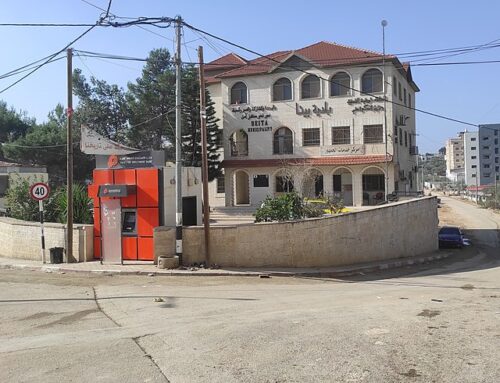The signs all over Tel Aviv leading up to the big demonstration read: “Where were you on September 3, 2011?” Well, I was together with 450,000 Israelis on the streets, over 300,000 in Tel Aviv alone, with another 50,000 in Jerusalem, and 100,000 in Haifa and the north.
 |
| Bibi: ‘You’re fired’ |
As I headed out for Habima Square, I felt a slight anxiety attack: there seemed to be too few people heading towards the Rothschild Blvd. Tent City headquarters. But the people kept coming. When I arrived at the “command headquarters”, everyone was in the midst of making makeshift homemade signs to carry, alongside the professional placards.
 |
| Faces of ‘revolution’ |
The main attraction was a French artist who set up a photographic studio on the square, and lines of people were entering to have their photo taken and then converted into a placard which presented the face of the revolution – you and me, every one of us. The placards were plastered above the nearby banks and supermarkets which are among the targets of the demonstration, on the square itself, and later held on high by some of the model/demonstrators, some carrying their own image, some carrying images of others.
In this digital age it was hard to tell the formal media from the citizen digital journalist/artist/documentarians since everyone was taking pictures of everyone else. People seemed to want to have a record that they were there on this historic day.
Among the attractions at the starting point was a protester proudly waving a Che Guevera flag, a man in an Israeli flag mask and costume, and even a life-size mannequin on the back of a motorcycle of kidnapped Israeli soldier Gilad Shalit, now past his fifth year in captivity in Gaza.
There were clusters of organized demonstrators: from the Israeli student union wearing blue shirts, green flags and “Bring Back the Welfare State” placards among the Meretz people, red flags and placards from the Hadash (Communist) people, the City for All of Us faction and the Arab-Jewish proletarian Da’am party, and the National Left people with a placard of a smirking Netanyahu with the slogan “You’re Fired!”– but mainly just plain people with their home-made signs.
My favorite was a toddler who obviously just learned to walk (more or less), who had a slogan on the back of his shirt saying “I cost a whole months’ salary for upkeep”. I complained to his mother that the slogan didn’t stand still long enough to take a clear photo, and she smiled: “What can I do? I’m just his mother.”
And then there were the two guys wearing a “We don’t need sex/we’re fucked enough by Netanyahu” t-shirt, who complained that my flash didn’t go off when I photographed them. ” Don’t worry,” I said.
The march headed out with drums, whistles and slogans, placards and flags held high, and turned left on Ibn Gvirol Street. The most popular slogans were “The People Demand Social Justice (Ha’am doresh/tzedek chevrati“, “Hoo, hah, look who’s coming/ the welfare state (Hoo ha, mi zeh bah/medinat harevacha)” and “The state is crumbling/get off your porches (Ha medina koreset/t’zu min hamirpeset)”, the latter two rhyming in Hebrew.
Truth is, even the porches were participating, with groups of people with pots and pans banging out their solidarity.
 |
| Inspiration from Tahrir Square |
As the throng neared the imposing Tel Aviv Municipal building overlooking Rabin Square where the prime minister was assassinated 16 years ago, a big whooshing protest noise was heard – perhaps because this was the only establishment symbol along the route. This, despite the fact that Mayor Ron Huldai, who declares that he is a social democrat, allowed the Tent City to squat on Rothschild Blvd, making no attempt to remove it. Opposite the stairs where Rabin was shot, I see a protestor carrying a sign – “Walk like an Egyptian.”
Among the hundred of thousands of unfamiliar faces, most of them young, I see a few that I recognize: Muki Tzur, the philosopher/preserver of the kibbutz movement heritage; Prof. Nissim Kalderon, the social-democratic literary critic who seems to pop up at every demo; Meretz Member of Knesset Nitzan Horowitz; Hanoch Sa’ar, a young education officer in the IDF back in the late ’70s who dreamed of establishing a publishing house (and did) who included my daughter Rama’s teenage poetry in his first publication; Prof. Galia Golan, a colleague at the
Palestine-Israel Journal who is co-coordinating our next issue on Women & Power; and even Marc Berthold, the director of the Israeli office of the Heinrich Boell Foundation associated with the Green Party, a direct link with Daniel Cohn-Bendit (Danny the Red), now co-president of the Green Party’s European Parliament faction, who was one of the leaders of the 1968 protests in France. The only identifiable member of the Labor Party I saw was Yariv Oppenheimer, Secretary General of Peace Now.
Yair Yanov, who was together with me on the Peace Now national leadership forum in the mid-’90s, explains all of the mistakes that the organizers have made. The route is too long and people are tired, and how could the Noar Haoved V’lomed (Habonim) youth decide to go directly to the square rather than participate in the march? He’s skeptical and somewhat pessimistic. My response: just remember that two weeks ago with the attack in the south and the security crisis, people were afraid that the protest would end; they never imagined that it was possible to revive it and have so many people participate. And believe me – this will have a profound, long-term impact.
 |
| All photos by H. Schenker in Tel Aviv |
We pass Arlozoroff Street near the Histadrut (General Federation of Labor) headquarters, the street named after Chaim Arlozoroff, one of the militant leaders of the pre-state labor movement who was presumably assassinated by followers of right-wing Revisionist leader Jabotinsky, the next street that we turn into towards our goal, Kikar Hamedina, the State Square, surrounded by Heh B’Iyar Street, the Hebrew date for the day that State of Israel was declared in 1948 – Zionist history in a nutshell. And someone is carrying a placard – “The War for Independence 2011”.
When I was on the kibbutz, every year the circus would come to town and set up a big tent in State Square. We would pile into a truck with the kids and come to the city to see the animals, daredevils and clowns. Now there are circuses without animals, animal right’s groups are also among the protesters, and State Square is surrounded by upscale shops and upper class homes. It’s also the biggest open space available in the Tel Aviv, which is why it was chosen to host “the mother of all protests”.
The old order is over – we are the “New Israelis” proclaims Yitzhak Shmuli (31), the articulate and charismatic head of the National Student Union. In a brilliant if somewhat demagogic speech, he declares that we will continue the protest as if there were no Government Trachtenberg Committee, and we will carry out a dialogue with the committee as if there were no protest. Careful not to mention the words ‘peace’, or even ‘social justice’, he gives a powerful rabble-rousing speech, says that the protesters are in it for the long haul, and introduces the name of a potential new political party that may evolve out of the protest movement, Yisrael Chadasha/New Israel. Shmuli rushed back from overseas to participate in the protest, and is reading Jon Lee Anderson’s biography of “Che Guevera: A Revolutionary Life” in its Hebrew translation. I remember Anderson and his brother Scott, when they worked with us at New Outlook on an investigative journalism project on Israeli arms dealings with questionable regimes in South America.
Cinema student Dafni Leef (25) is Shmuli’s counterpart, and in many ways opposite. She began the whole process seven weeks ago when she announced an “Event” on Facebook and with a few friends set up the first tent on Rothschild Blvd. People knew that Saturday night’s demo would be a success because 350,000 people had already pressed the Facebook button ‘Yes’, not ‘No’ or ‘Maybe’, to the question of whether they were coming to the 9/3/11 “Event”.
 |
| Images of Dafni Leef & Stav Shafrir, protest leaders |
Leef gave a passionate, very personal speech. They tried to slander us, at first calling us spoiled brats, sushi and nargila (water pipe) lovers. Then they said we were left-wing extremists. And then they said the attack in the south would cause us to fold up our tents, and they didn’t understand that we were mourning for the loss of innocent lives, but were not giving up. And then they attacked me personally – referring to the fact that a right- wing organization had discovered that in 2002, when she was 17, she had signed the annual 12th graders letter declaring a refusal to serve in the army in the Occupied Territories, a variation on the letter my son Adi and 250 other 12th graders signed in 2005.
Leef defiantly declared that the reason she didn’t serve in the IDF was for health reasons (epileptic fits), she would have served otherwise, and she volunteered for a year and half to help problematic youth in disadvantaged neighborhood, giving service to society. “I am in the center, and no one can push me into a corner!” They will not cause us to stand down, or give up. She also dared to attack the current form of Israeli capitalism as the root of all evil. A hush came over the crowd when she recalled a poet friend who committed suicide two months before the protest began, because he felt that given the state of Israeli society, he couldn’t dream, couldn’t be a poet. We must create a society where young people can have the right to dream, to be poets she exclaimed.
Motti Ashkenazi was there to recall the popular protest he started after the Yom Kippur War in 1973, though most of the people around me seemed to be wondering who he was. There was also an impressive 11th grade teacher, leader of the teacher’s protests, who spoke about Jewish-Arab solidarity, and the right to quality education for all; a passionate single mother from a development town studying at the Kibbutz Movement Educational Seminary who shouted “Wake up Israel!”; Prof. Yossi Yonah, one of the heads of the advisory committees set up to advise the protest movement on policy; and even veteran stage personality/performer Rivka Michaeli, who said she was representing the senior citizens.
There were a few signs stating “Social Justice = An End to the Occupation”. The issue of peace and security was not at center stage, but that will come. There was also one lone sign held by two youth protesting against “Dafni Leef and her hallucinatory leftwing friends – this protest belongs to all of us”, but they seemed to be ignored by ‘the masses’.
And of course there was music, there is no revolution without music: Hayehudim(The Jews), one of the leading punk rock groups (clearly not to everyone’s taste); Dag Nachash, the popular Israeli hip hop/funk group led by Sha’anon Street who totally identifies with the protest movement in word and song; and Mizrachi singer Eyal Golan, considered perhaps the most popular Israeli singer during the past decade, and also not a bad soccer player, who had the young people swaying in the square.
So what does it all mean? First of all, the 9/3/11 demonstration was a tremendous success, against all odds. But it is not an ad-hoc one time phenomenon. It is the climax of an extraordinary, unexpected Israeli summer of social protest, a link in the chain of grassroots social protests sweeping the Middle East, Europe and Latin America in the spring and summer of 2011.
There will be no overnight revolutionary transformation in Israeli life. But as Dafni Leef declared, the movement has initiated a fundamental change in the Israeli discourse. And as all of the young leaders and most of the commentators state that the events of this past summer will have a profound impact on the long term direction of Israeli society. There were placards which read “We’re Going into Politics – Register for a Party – Change from Within!” not calling for joining any particular party, but to simply get involved in the process. During the past decade, the percentage of Israelis voting in national elections dropped from 85% to 62%. That is going to change, particularly among the previously apathetic, sometimes hedonistic and fatalistic younger generation and middle class, and also among the 20% of the Palestinian-Arab citizens. Old parties will have to change or step aside, and new forces may emerge.
And the Trachtenberg Committee will come forward with its recommendations, and both the government and the protesters will have to respond to them. The summer of 2011 will be a summer to remember, a summer which has aroused a sense of forgotten pride in many Israelis.
Now the hard work continues.
.











Dear Hillel,
Great to read that the rights of Palestinians living in Israel, under Israeli military occupation and in exile played such a large role in the protest and in your summary of it.
I doubt it is of any significance that amongst your 2,174 words on the protest, a reader would only find the word Palestinian a single time, in your third to final paragraph (“That is going to change, particularly among the previously apathetic, sometimes hedonistic and fatalistic younger generation and middle class, and also among the 20% of the Palestinian-Arab citizens.”)
Nor should we expect the pre-emininent social justice issue in Israel, the denial of Palestinian rights, to be featured in these protests or Meretz’s aummary of them. After all, as you told us, in one of the two other places where you briefly touched on this issue: “There were a few signs stating “Social Justice = An End to the Occupation”. The issue of peace and security was not at center stage, but that will come.”
Yes, it will come, at the very end, or more likely not at all, unless of course we are remembering injustices against Israelis committed by Palestinians, in your third mention of the issue, early on in the article:
“Among the attractions at the starting point was a protester proudly waving a Che Guevera flag, a man in an Israeli flag mask and costume, and even a life-size mannequin on the back of a motorcycle of kidnapped Israeli soldier Gilad Shalit, now past his fifth year in captivity in Gaza.”
I’m sure Egyptians and all Arabs find entire acceptable Israeli appropriation of the themes of their revolutions for use in Israel’s cottage cheese revolution that avoids all mention of Palestinians.
What do I conclude conclude from this summary? The protests are a whitewash focused entirely on issues of concern to Israeli Jews, and reporters like you, sadly, have no intention whatsoever of bringing Palestinian rights to the forefront or pointing out the complete hypocrisy of the protests.
Social justice for whites in the Jim Crow South and for Boers in apartheid South Africa! Yes, I’m sure those campaigns too were stepping stones toward equal rights for the unmentionable “other.”
Ted
Ted,
You’re far from the first to raise this legitimate issue, but your tone undermines your argument. You also either ignore, or are not aware of, the fact that the blogger, Hillel Schenker has been involved in Palestinian-Israeli peace and reconciliation efforts for decades, including in his current position as co-editor, with Ziad AbuZayyad, of the Palestine-Israel Journal. Surely you don’t suspect him of being part of a ‘whitewash’?
As for the substantive aspect of the issue you raise, here’s what I wrote in a column last week (full column at http://www.meretzusa.org/the-challenges-ahead-israel%E2%80%99s-tent-protest-movement )
” … what would happen to the movement if and when it extends the application of ‘justice’ beyond Israel’s Green Line border and into the territories occupied by Israel? Will the movement endorse the concept of justice for non-citizen Palestinians living in the West Bank? And, if so, what will be the response of the hundreds of thousands of Israelis who support the Tent Protests, precisely because it’s not considered part of ‘the Left’?
“The optimists argue that political consciousness-raising is a gradual process that needs time to develop, but that ultimately the Israeli people will see the inherent connections and make the conceptual leap. The Tent Protest, after all, is an ambitious campaign that goes far beyond mass marches, and includes ongoing intensive efforts at education, reminiscent of the ‘teach-ins’ in 1960s America.
“Still, one must be concerned that, weighed down by the pressure to maintain strength and unity amid the tumultuous events expected in the coming months, the Tent Protest will end up calcifying around the lowest common denominator of immediate economic relief for those who live within 1967 Israel, and particularly for its Jewish majority.”
I agree there’s cause for concern, here, but I am willing to trust the many progressive voices I’m hearing in Israel who insist that the protest movement should and can be a vehicle for change on the Occupation front as well.
BTW: Please have a look at the Joint Palestinian-Israeli statement supporting the protest movement – http://972mag.com/joint-palestinian-israeli-statement-supporting-j14-end-to-occupation/
Are they whitewashing as well?
I have another question for you, Ted; how much do Palestinians actually care about Israeli domestic politics, as those were the origins of this protest? I’m not asking them to emphasize or even like their occupiers, but if they don’t exactly care, why would Israel involve them? The Israeli and Palestinian national movements, after all, don’t have the best history of cooperation, to put it lightly.
As an aside, why should the Arab world especially care about their ‘symbols of revolution’ being used by Israel, and vice versa? The protests are significantly different in nature, and much of the Arab world doesn’t recognize Israel, let alone care about their protests unless it involves the occupation.
And one more thing. The differences between Israel and the bigoted countries you mentioned are far too different to summarize effectively in one post. However, social justice should be universal in a country, regardless of the laws in place. All people deserved social justice in the South, and if there was a exclusivist campaign solely for it doesn’t mean they didn’t deserve it. According to your logic, does social justice in the Arab/Muslim worlds mean nothing due to often tolerated contempt and intolerance they’ve shown towards different groups?
The answer is no. Egyptians deserved social justice no matter how Coptics are treated. Israeli’s deserve social justice, regardless of the occupation or not.
‘Fight the occupation like there was no social justice, and fight for social justice like there was no occupation’.
Dear Ron,
Thanks. I am aware that I’m not the first person to raise this glaringly obvious issue.
I know who Hillel is. His report is very much a “whitewash,” for the reasons I explained above. If you would like to explain how I missed it and that his report actually addresses the issue of Palestinian rights, that would be welcome.
I’m glad you agree there is reason for concern that these protests do not address Palestinian rights. Frankly, despite your “trust” I see no sign that these protests will address this issue. In fact, the protests have been founded on the specific refusal to address the issue of Palestinian rights. Hillel’s report, as just one of hundreds of examples, shows their absence from the protesters’ agenda. If you’d like to explain what I’m missing, I’d welcome that.
Lastly,I cannot explain why these DFLP and People’s Party organizations have signed onto the statement of support for the J14 protests (You may or may not be aware that most of the Palestinian signers represent those two parties). Though I do not want to dminish them because I do have friends in both parties, I do have to note that these two Palestinian parties have dwindling and very support amongst Palestinians. Perhaps there was a kind of desperate hope that by expressing support for the protests this would encourage the protests to take into account Palestinian rights. Personally, while I understand people might try, I think all signs indicate that is a futile hope, people should disabuse themselves of this notion, and focus their energies on more productive ways of bringing about human rights for all.
Ted